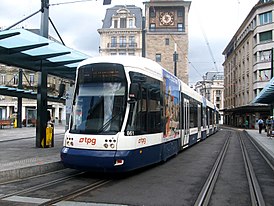Trams in Geneva

A Flexity Outlook Cityrunner in Geneva.
|
|||
| Operation | |||
|---|---|---|---|
| Locale | Geneva, Switzerland | ||
| Open | 1862 | ||
| Status | Open | ||
| Lines | 4 | ||
| Operator(s) | Transports Publics Genevois | ||
| Infrastructure | |||
| Track gauge | 1,000 mm (3 ft 3 3⁄8 in) metre gauge | ||
| Electrification | 600 V DC Catenary | ||
| Stock | 46 Duewag-Vevey 39 Bombardier Cityrunner 14 Stadler Tango |
||
| Statistics | |||
| Route length | 36 km (22 mi) | ||
|
|||
| Website | Transports Publics Genevois (French) | ||
The Geneva tramway network (French: Réseau tramway de Genève) is a network of tramways forming the core element of the public transport system in Geneva, Switzerland. It is operated by Transports Publics Genevois (TPG), and is supplemented by the Geneva trolleybus system and numerous motor bus lines.
Opened in 1862, the network had grown sufficiently by 1920 to be the largest in Europe. However, by 1960 it had contracted to just one line. Since 1995, it has been greatly expanded. It presently has four tram lines, and further expansions are planned.
Geneva's and Switzerland's first trams ran on 19 June 1862, with the opening of a horsecar tramway between Place Neuve and Carouge. In 1889, a steam tramway was opened, and in 1894 Geneva's first electric tram entered service. Finally, in 1899, the Compagnie Genevoise des Tramways Électriques (CGTE), predecessor of the TPG, was inaugurated.
The CGTE set itself the goal of unifying the various systems. All lines were electrified and converted to a uniform metre gauge.
For nearly three months in 1904, the CGTE also operated the steepest adhesion railway in Switzerland. The incline reached 11.8%, but the dangers posed by such steep inclines brought about the swift demise of this line.
In the 1920s, the city and the canton had the largest network of urban and suburban tramways in Europe. As of 1923, a total of 120 km (75 mi) of tramways had been built. The network extended into the countryside, and even across the border into France.
In 1925, the CGTE began to convert its interurban lines to bus operation. This process continued in the city centre, where the lines were partly replaced by trolleybuses. By 1969, the network had shrunk to just one 8 km (5.0 mi) long tramway, which was served by line 12 (Moillesulaz–Carouge). The good technical condition of the tramcars and the fact that they had not yet been withdrawn from service, led to the provisional retention of the last tramway.
...
Wikipedia

